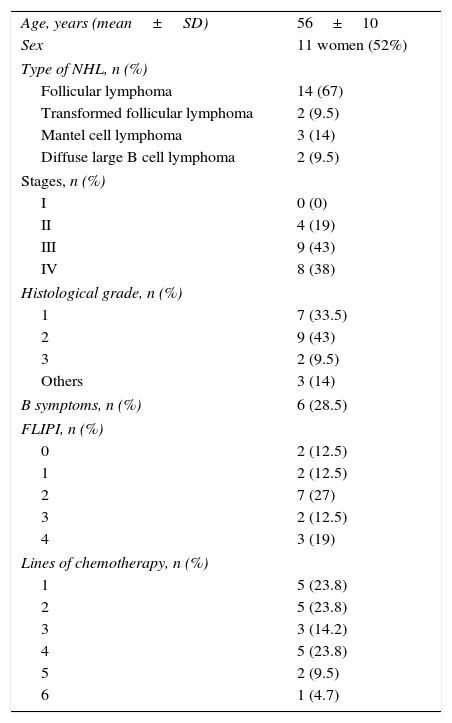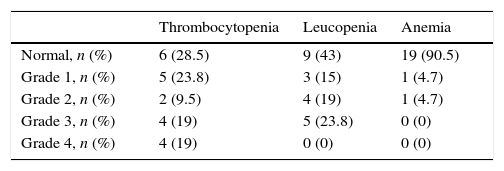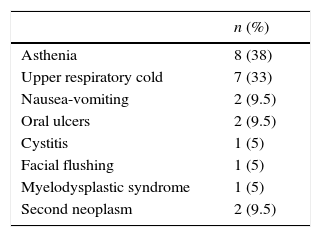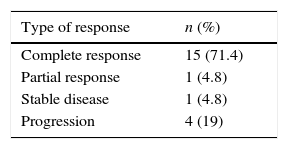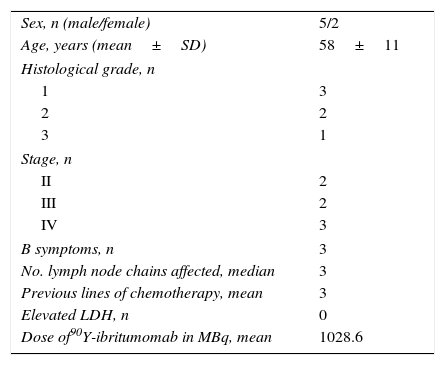Radioimmunotherapy (RIT) is one of the therapies directed against molecular targets in non-Hodgkin's lymphoma (NHL).
ObjectiveTo evaluate the positioning, safety, and effectiveness of RIT with 90Y-ibritumomab in NHL patients.
MethodA retrospective study was conducted on patients with NHL who received RIT with 90Y-ibritumomab. An evaluation was made of the concordance with clinical guidelines, toxicity as rated by the Common Terminology Criteria for Adverse Events (CTCAE), and effectiveness was assessed based on response to treatment, overall survival (OS), and progression-free survival (PFS).
ResultsRIT was requested in 26 patients, of whom 21 (11 women, mean age 56±10 years) were included in the study, with the following distribution: Follicular NHL, 67%, Mantle NHL, 14%, Diffuse large B-cell NHL, 9.5%, and Transformed NHL 9.5%. Twelve patients with refractory NHL, 7 for consolidation response, and 2 transplant conditioning, were treated. Adverse effects were observed in 71% of patients, which were usually manageable and transient, and with the most common being thrombocytopenia. At 3–4 months, overall response rate was 76.2% (71.4% complete and 4.8% partial response), and 19% had progression of disease. With a median follow-up of 70 months, the OS was 96±8 months, and the PFS was 54±11 months.
ConclusionRIT showed a moderate correlation with clinical guidelines, and is probably underused. Adverse effects were common, mild, and manageable. The data show a high complete response rate and an increase in the OS and PFS.
La radioinmunoterapia (RIT) es uno de los tratamientos dirigidos contra dianas moleculares del linfoma no Hodgkin (LNH).
ObjetivoEvaluar el posicionamiento de la RIT con 90Y-ibritumomab en pacientes con LNH, así como su seguridad y efectividad.
MétodoEstudio retrospectivo de pacientes con LNH que recibieron RIT con 90Y-ibritumomab. Se evaluaron la concordancia con las guías clínicas, la toxicidad según la clasificación Common Terminology Criteria for Adverse Events (CTCAE) y la efectividad en función de la respuesta al tratamiento y de la supervivencia global (SG) y la supervivencia libre de progresión (SLP).
ResultadosSe solicitó RIT en 26 pacientes, de los que 21 (11 mujeres, edad media ± desviación estándar 56±10 años) fueron incluidos en el estudio, con la siguiente distribución: LNH folicular 67%, LNH del manto 14%, LNH difuso de células B grandes 9,5% y LNH transformado 9,5%. Se trató a 12 pacientes con LNH refractario, 7 para consolidación de respuesta y 2 para acondicionamiento a trasplante. El 71% de los pacientes presentó efectos adversos, generalmente manejables y transitorios, siendo la trombocitopenia el más frecuente. A los 3-4 meses, se obtuvo una tasa de respuesta global del 76,2% (completa en 71,4% y parcial en 4,8%) y el 19% mostró progresión de su enfermedad. Con una mediana de seguimiento de 70 meses, la SG fue 96±8 y la SLP de 54±11 meses.
ConclusionesLa RIT presentó una moderada correlación con las guías clínicas y probablemente esté infrautilizada. Los efectos adversos fueron frecuentes, leves y manejables. Los datos muestran una alta tasa de respuesta completa y una prolongación de la SG y la SLP.
Article

Revista Española de Medicina Nuclear e Imagen Molecular (English Edition)










